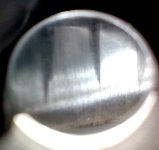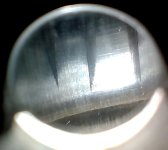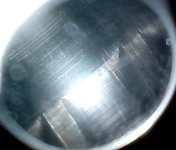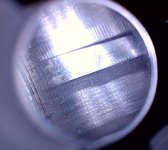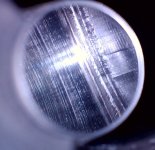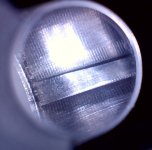heard good things about the savage 338s, and that is a NICE piece of glass. I am assuming you bore scoped it is you were looking at the lands. How did it look for your rifle? Mine was an improvement, but not as much as I had hoped, and not as even over all as I had expected.
You are using an out of date browser. It may not display this or other websites correctly.
You should upgrade or use an alternative browser.
You should upgrade or use an alternative browser.
tubbs final finish bullets
- Thread starter Shadow9mm
- Start date
stagpanther
New member
Yes, I used a borescope the lead into the lands you can see the rifling tapers off into uneven lengths to the freebore, and the ends are arrow-shaped as opposed to right-angled. I'll try to get a picture.I am assuming you bore scoped it is you were looking at the lands. How did it look for your rifle?
Last edited:
very interestingYes, I used a borescope the lead into the lands you can see the rifling tapers off into uneven lengths to the freebore, and the ends are arrow-shaped as opposed to right-angled. I'll try to get a picture.
stagpanther
New member
I just took a closer look at the lead to lands in my 300 Weatherby mag which I also finished with 10 shots of #5 tubbs today--some of the groove ends look "erased."
stagpanther
New member
As you wish.That description is odd. I'd like to see a photo, too.
I obsess much more about the last few inches of the barrel than the first few.I am assuming you bore scoped it is you were looking at the lands. How did it look for your rifle?
Attachments
Last edited:
Interesting pix.
You do whatever pleases you.
For myself,I don't look at firelapping as a routine project to do on new rifles.
I don't know,Mr Tubbs might.
If I'm satisfied a barrel shoots good enough for my purpose,I leave it alone.
I would not firelap a good custom barrel. The one I did was a "bargain" Brownells pre-thread.pre-chambered for around $100.
Looking in the muzzle with a loupe,I could see reamer marks across the lands and button gall marks that looked like smeared cheddar cheese.
And all of it would clog with copper. And,it didn't shoot well.
I shrugged,figured I was stupid to buy a cheap barrel,also figured I had nothing to lose. I couldn't hurt it.
Bore scopes are cool. I don't have one. My measure of success was "Does it shoot?" In this case, accuracy improved so I was quite happy.
I look at it as a chance to make an otherwise junk barrel work.
If it does not work...Oh well!!
You do whatever pleases you.
For myself,I don't look at firelapping as a routine project to do on new rifles.
I don't know,Mr Tubbs might.
If I'm satisfied a barrel shoots good enough for my purpose,I leave it alone.
I would not firelap a good custom barrel. The one I did was a "bargain" Brownells pre-thread.pre-chambered for around $100.
Looking in the muzzle with a loupe,I could see reamer marks across the lands and button gall marks that looked like smeared cheddar cheese.
And all of it would clog with copper. And,it didn't shoot well.
I shrugged,figured I was stupid to buy a cheap barrel,also figured I had nothing to lose. I couldn't hurt it.
Bore scopes are cool. I don't have one. My measure of success was "Does it shoot?" In this case, accuracy improved so I was quite happy.
I look at it as a chance to make an otherwise junk barrel work.
If it does not work...Oh well!!
stagpanther
New member
I agree with this. It's a judgement call and there is a balance of harmful vs good lapping that I take into consideration and none of my custom SS barrels need it at this point AFAICT. In the case of my recent savage barrels, even new they have enough what appears to me to be tooling damage at the last couple of inches to bore exit at the muzzle to make me want to consider using the fire-lapping.You do whatever pleases you.
For myself,I don't look at firelapping as a routine project to do on new rifles.
I shot the Tubbs lap kit for my Savage 6mm CR. After breaking it in. shoot clean... The fouling was hard to remove and patches did not slice smoothly down barrel. So I Tubbed it. It's shooting about 1/2" at 100 Yds. I'm waiting to get some warmer weather to try a new bullet, powder and if I can find my CCI 4BR primers. I have a box of Burger 108 gr. pills to try. 
stagpanther
New member
I'm not jumping to any conclusions about that wear in the lead--could be all kinds of things going on that I don't have a clue about. My pet theory is that the lead is a "constriction area" for a bullet which is likely to be somewhat off concentric relative to the bore as it is "squeezed" to the lands (?). Another guess is that the rifling cutter may have some "drift" in the initial cut depth due to taper of the lead (?) so the lapping action may be actually be making it more uniform (?). Beyond my pay grade and I invite the real experts to comment. 
Stagpanther: I;m not entirely certain I see the eccentricity you are talking about.
I suspect its not about the bore or rifling. More likely in the chambering.
Chambering reamers have a pilot that follows the bore.There are solid pilots and interchangable pilotsSolid pilots are the dia the reamer maker ground them.Bore dias vary some.A pilot might be a little loose.
Reamer holding setups vary.I don't know how production rifle chambering goes.
Could be our person shows up to work and gets a basket of 100 barrels to chamber.Time is money. I indicate the bore true on both ends to within a couple of tenths TIR.
Suppose our person making production rifles does? I suspect he/she relies on chucking the OD.
I suspect its not about the bore or rifling. More likely in the chambering.
Chambering reamers have a pilot that follows the bore.There are solid pilots and interchangable pilotsSolid pilots are the dia the reamer maker ground them.Bore dias vary some.A pilot might be a little loose.
Reamer holding setups vary.I don't know how production rifle chambering goes.
Could be our person shows up to work and gets a basket of 100 barrels to chamber.Time is money. I indicate the bore true on both ends to within a couple of tenths TIR.
Suppose our person making production rifles does? I suspect he/she relies on chucking the OD.
Last edited:
if you look at the rifling, relative to the throat, the left side of a land is higher up into the more than the right.Stagpanther: I;m not entirely certain I see the eccentricity you are talking about.
I suspect its not about the bore or rifling. More likely in the chambering.
Chambering reamers have a pilot that follows the bore.There are solid pilots and interchangable pilotsSolid pilots are the dia the reamer maker ground them.Bore dias vary some.A pilot might be a little loose.
Reamer holding setups vary.I don't know how production rifle chambering goes.
Could be our person shows up to work and gets a basket of 100 barrels to chamber.Time is money. I indicate the bore true on both ends to within a couple of tenths TIR.
Suppose out person making production rifles does? I suspect he/she relies on chucking the OD.
I suspect this is from the twist....if the bullet is rotating the pressure would no only be forward, but down on the side of the lands as well as the bullet was forced to rotate.
stagpanther
New member
Here is a pic of the lead in an unfired savage 308 barrel I pulled off a donor rifle. It looks to me like a pretty clean, well-defined transition from the end of the freebore. What I speculate happens is that the lapping bullets "rounds off" the transition from the freebore to lead, and any eccentricity of the bullet is what is adding to the unevenness in the beginning of the rifling groove which is "moved" up the bore (away from the chamber) and gives the ends that distinctive arrow look.

Attachments
So I have a new theory. I think rather than pushing the lands back, it reduced their height, which allowed me to seat bullets farther forward before hitting resistance. I am note sure how I feel about that though.
Some of the start of the lands seem to have been tapered more than others
Also you can see the flattened ramp where the lands start that is highly polised transition into the top part of the lands that are polished, but you can still see the horizontal tooling marks under and on the sides.
Land not pushed back, you can see it is right near the throat

a land that is pushed back, also note the taper compared to the one not pushed back

And finally a transition. also note, it made little to no difference in the grooves as they still have heavy tooling marks

Some of the start of the lands seem to have been tapered more than others
Also you can see the flattened ramp where the lands start that is highly polised transition into the top part of the lands that are polished, but you can still see the horizontal tooling marks under and on the sides.
Land not pushed back, you can see it is right near the throat
a land that is pushed back, also note the taper compared to the one not pushed back
And finally a transition. also note, it made little to no difference in the grooves as they still have heavy tooling marks
Attachments
stagpanther
New member
Feel free to mention my interesting results--but keep in mind I have not in any way found evidence that the treatment has been detrimental to the performance of the rifle (yet, anyway). I hope to start developing loads soon to see what effect may have been made.So a quick update. I contacted Tubbs, it was a form on their website. They e-mail back and said to call them, let a number and said to ask for Bryan, who can "help me with my questions and issues". gonna call tomorrow.
will do. I have not been able to get to the range to accuracy test yet, got the covid (almost better, ended up being just a real bad head cold with chest congestion) and have been stuck in the house. I am free tuesday and going to the range wednesday if the weather is even 1/2 way reasonable.Feel free to mention my interesting results--but keep in mind I have not in any way found evidence that the treatment has been detrimental to the performance of the rifle (yet, anyway). I hope to start developing loads soon to see what effect may have been made.
I will post again when i get testing done, let me know how yours goes. I'm just curious to see if they say these results are within the normal range.
stagpanther
New member
Maybe ignorance is bliss--I probably wouldn't have felt motivated to do the fire-lapping had I not seen the damage--or let's call it "more chatter than normal"--especially that deep gouge. I'm still wondering what causes that pitting near the muzzle in my savages--like the barrel was dipped in something after the bore work was done?
Stagpather,
That's a new one on me. It that unevenness uniform all around? If it is only on one side, the off-center chambering reamer explanation could explain it. If it is all around, I'll guess the grooves are not even in height across their width. You can test that by slugging with a pure lead ball or cast bullet and measuring it with a micrometer.
Shadow 9mm,
In your images it appears to me the throat angle may have been flattened some. There are cleanup marks in the middle of your grooves, but they are absent from the floor of the grooves as they approach the corners of the lands. This is common lapping with jacketed bullets as the lands indent the bullet surface but don't really cut it, so you get a radius on the jacket where it comes off the engraving mark. That part of it is not touching down in the groove to remove the tooling marks. Lapping with cast bullets leaves less of that untouched area. Look for higher pressure loads than you used with the Tubbs kit to fill the bore better and to possibly leave copper streaks where the groove cleanup stopped.
Not using coarse abrasive on a good barrel is common sense. If it was an air gauged button-rifled and stress-relieved blank like a Douglas, then you won't have constrictions to remove, so all you need is to polish enough that it can't grab copper anymore.
Constrictions can be a big issue, especially for shooting cast bullets. A button-rifled barrel that wasn't stress-relieved before contouring will be narrower where the contour is thickest, and you need some cutting action to bring it up to the diameter of the muzzle. The last military barrel I firelapped was in a Garand and was 0.0003" narrower near the chamber than at the muzzle, and to shoot cast bullets well, that constriction had to go. In the end, the cast bullets took 0.0005" off the throat diameter and about 0.0001" off the muzzle diameter.
Nick
That's a new one on me. It that unevenness uniform all around? If it is only on one side, the off-center chambering reamer explanation could explain it. If it is all around, I'll guess the grooves are not even in height across their width. You can test that by slugging with a pure lead ball or cast bullet and measuring it with a micrometer.
Shadow 9mm,
In your images it appears to me the throat angle may have been flattened some. There are cleanup marks in the middle of your grooves, but they are absent from the floor of the grooves as they approach the corners of the lands. This is common lapping with jacketed bullets as the lands indent the bullet surface but don't really cut it, so you get a radius on the jacket where it comes off the engraving mark. That part of it is not touching down in the groove to remove the tooling marks. Lapping with cast bullets leaves less of that untouched area. Look for higher pressure loads than you used with the Tubbs kit to fill the bore better and to possibly leave copper streaks where the groove cleanup stopped.
Not using coarse abrasive on a good barrel is common sense. If it was an air gauged button-rifled and stress-relieved blank like a Douglas, then you won't have constrictions to remove, so all you need is to polish enough that it can't grab copper anymore.
Constrictions can be a big issue, especially for shooting cast bullets. A button-rifled barrel that wasn't stress-relieved before contouring will be narrower where the contour is thickest, and you need some cutting action to bring it up to the diameter of the muzzle. The last military barrel I firelapped was in a Garand and was 0.0003" narrower near the chamber than at the muzzle, and to shoot cast bullets well, that constriction had to go. In the end, the cast bullets took 0.0005" off the throat diameter and about 0.0001" off the muzzle diameter.
Nick

